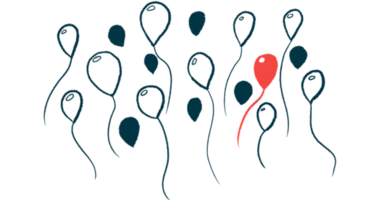Beqvez (fidanacogene elaparvovec-dzkt) for hemophilia
Last updated March 11, 2025, by Lindsey Shapiro, PhD

What is Beqvez for hemophilia?
Beqvez (fidanacogene elaparvovec-dzkt), previously known as SPK-9001 or PF-06838435, was a gene therapy approved in the U.S. to treat certain adults with moderate to severe hemophilia B. It was designed to prevent bleeding episodes in patients with this disease type, which accounts for about 15% to 20% of all hemophilia cases.
The therapy also was approved in Canada and Europe to treat severe and moderately severe hemophilia B in adults. In Europe, it was being marketed under the brand name Durveqtix.
The one-time therapy, given via an intravenous, or into-the-vein, infusion, was marketed by Pfizer, which made the decision to halt its development and commercialization in February 2025 in large part due to the limited interest shown by patients and doctors on hemophilia gene therapies. Roche subsidiary Spark Therapeutics had been codeveloping the therapy, but transferred full responsibility to Pfizer in 2018.
Therapy snapshot
| Brand name: | Beqvez |
| Chemical name: | Fidanacogene elaparvovec-dzkt |
| Usage: | Gene therapy to prevent bleeding episodes in hemophilia B |
| Administration: | Intravenous infusion |
How does Beqvez work?
Hemophilia B is caused by mutations in the F9 gene, which carries instructions for making factor IX (FIX), a protein involved in the formation of blood clots. Mutations in the gene cause the protein to be faulty or missing completely and blood clotting to be impaired, leading to the recurrent and difficult to control bleeding episodes that characterize the disease.
Beqvez was a gene therapy designed to deliver a highly functional version of F9 to liver cells, where blood clotting factors are mostly produced. The version of F9 Beqvez delivered is called Padua, a naturally occurring form of the gene containing a single mutation that encodes a version of FIX that has five to 10 times greater clotting activity than the regular form of the protein.
The gene was packaged inside a specialized adeno-associated virus (AAV) carrier. It contained a recombinant, or lab-made, outer shell, known as AAVRh74var capsid, which helped it be taken up by liver cells when delivered via an intravenous infusion. The AAVRh74var capsid was derived from a naturally occurring AAV serotype (Rh74) that’s not known to cause disease in humans.
Once the gene therapy components were taken up, target cells could use the F9 gene to continuously produce their own version of FIX, thereby preventing bleeding episodes.
Who could take Beqvez?
The U.S. Food and Drug Administration (FDA) approved Beqvez in April 2024 for treating adults with moderate to severe hemophilia B who use preventive (prophylactic) FIX replacement therapy, have a current or past history of life-threatening bleeds, or have repeated, serious spontaneous bleeding episodes, and who do not have neutralizing antibodies against the AAVRh74var capsid.
Beqvez was also approved by Health Canada in 2024, and by the European Union in July, for adults with moderately severe to severe hemophilia B.
Who should not take Beqvez?
There were no contraindications for Beqvez’s use, but hemophilia B patients must have undergone certain tests to make sure they were eligible for treatment.
Beqvez should not have been used in patients in whom blood tests came back positive for:
- neutralizing antibodies against the AAVRh74var capsid, as detected by an FDA-approved companion diagnostic test
- neutralizing antibodies (inhibitors) against FIX, or a prior history of such inhibitors
- signs of active HIV-1 or HIV-2 infection.
Liver health assessments also had to be performed before treatment, and patients with certain liver conditions may not have been eligible for Beqvez or require special consultation with a hepatologist before receiving treatment. Hepatologists are doctors who diagnose and treat diseases associated with the liver and other organs of the digestive system.
Beqvez also should not have been used by patients with a history of exaggerated immune responses, or hypersensitivity, to FIX replacement therapies. The therapy also was not intended to be used in women.
How was Beqvez administered in hemophilia?
Beqvez was given as a single intravenous infusion, lasting about an hour, and administered at a hospital or clinic. This had to be done under the supervision of a physician experienced in the treatment of hemophilia. The therapy’s recommended dose was 5×1011 vector genomes per kilogram of body weight (vg/kg), with certain adjustments in heavier patients who had a body mass index (BMI) greater than 30. BMI is a person’s ratio of weight to height, and is used as a measure of body fat.
The medication came as a liquid suspension in vials at a concentration of approximately 1×1013 vg/mL that were to be diluted in sterile saline and human serum albumin for infusion. A doctor would determine how many vials were necessary to meet the weight-based dose requirements. Beqvez was to be administered within a period of 24 hours after being prepared.
After the infusion, Beqvez could be transmitted from a patient to others through bodily excretions and secretions, such as urine, feces, saliva, mucus, or semen. Patients should have been instructed about proper hygiene methods to avoid such transmission, and these precautions should be taken for six months after the infusion, especially if a patient was in close contact with any person who was pregnant or immunodeficient.
After Beqvez was administered, lab tests for liver function and FIX activity were recommended once or twice weekly for the first four months. The frequency of these tests could gradually be reduced over the first six years following treatment. Following the sixth year, testing should be done annually. Certain changes in liver enzymes or FIX activity might have warranted treatment with corticosteroids.
Beqvez in hemophilia clinical trials
The safety and pharmacological properties of Beqvez were initially investigated in an open-label Phase 1/2a study (NCT02484092) involving 15 men with hemophilia B. The men were experiencing at least four bleeds per year on average and required on-demand or preventive treatment with FIX products.
All received a single infusion of the gene therapy, given at a dose of 0.5 trillion vg/kg, but the last five patients were treated with an improved version. The participants then were followed for up to a year. A long-term observational study (NCT03307980) continued to follow these individuals, as well as a subgroup of patients who didn’t participate in the earlier trial and received a higher dose of the therapy.
Results announced in 2018, with a follow-up time of five to 121 weeks post-treatment, showed average bleeding rates decreased by 98% within four weeks. The participants went from having an average of 8.9 bleeds per year before receiving the gene therapy to 0.2 bleeding episodes per year after treatment.
Further, the participants also stopped taking their preventive FIX infusions, with the annualized rate of infusions used to control or prevent bleeds dropping by 99%.
BENEGENE-2 trial
After the promising results from the Phase 1/2a study, a Phase 3 clinical trial called BENEGENE-2 (NCT03861273) was launched to evaluate the gene therapy in a larger population of hemophilia B patients. Pfizer’s regulatory applications seeking Beqvez’s approval were based on data from this trial.
The study enrolled 45 men, ages 18-65, with moderately severe to severe hemophilia B, who had FIX activity levels of 2% or lower than normal. The participants first took part in a lead-in study (NCT03587116) in which they were monitored for at least six months while on standard FIX replacement therapy. They then received a single intravenous infusion of Beqvez at its formerly recommended dose of 5×1011 vg/kg.
Results showed the mean annualized bleeding rate dropped from 4.5 bleeds per year in the lead-in study to 2.5 bleeds per year during the Beqvez efficacy period, the period spanning between three months after the infusion and the data cutoff, with a median follow-up of 1.8 years.
The median annualized bleeding rate similarly declined from 1.3 bleeds per year in the lead-in study to 0 after Beqvez was administered. More than half the participants (60%) did not experience any bleeds after receiving the gene therapy, while fewer than one-third (29%) did while on replacement therapy during the lead-in study. Six people (13%) resumed FIX replacement therapy from 0.4 to 1.7 years after receiving Beqvez.
Patients will be evaluated for up to 15 years to assess the gene therapy’s long-term safety and efficacy outcomes, including six years in BENEGENE-2 and an additional nine years as part of a separate Phase 3 extension study (NCT05568719).
Common side effects of Beqvez
The most common side effect associated with Beqvez in clinical trials was an increase in the levels of certain liver enzymes.
Liver toxicity
Intravenous infusions of a liver-directed viral carrier, such as the one used in Beqvez, could lead to elevations in the levels of certain liver enzymes. It also could potentially reduce the treatment’s therapeutic efficacy.
Liver enzyme levels should have been monitored once or twice weekly for at least four months after Beqvez treatment. Should elevations in liver enzymes and/or decreases in FIX activity occur, corticosteroid treatment should be started as needed, while monitoring patients for adverse side effects and adjusting vaccination schedules as necessary. In the first year after receiving Beqvez, patients also should have limited their alcohol consumption, because alcohol can impact liver function.
It also was possible that certain medications that compromise liver function might reduce Beqvez’s efficacy or increase the risk of serious liver-related events. Physicians should review all medications that patients were taking to determine if modifications needed to be made before Beqvez was administered.
Infusion reactions
Infusion-related reactions, including hypersensitivity or anaphylaxis — a life-threatening reaction — might occur after treatment with Beqvez, with symptoms including low blood pressure, fever, palpitations, nausea, vomiting, chills, or headache. Patients should have been closely monitored for signs of a reaction during the infusion and for at least three hours afterward. If a reaction had occurred, the infusion might have been slowed or stopped and restarted at a slower rate after the issue was resolved. Treatment with antihistamines, corticosteroids, or other medications might also have been considered.
Cancer
The integration of a viral carrier into human liver cells carries a theoretical risk of liver cancer. Patients with other risk factors, such as hepatitis, fatty liver disease, alcohol consumption, or advanced age should have been monitored annually for the first five years after dosing.
FIX levels and development of inhibitors
FIX levels should have been regularly measured and patients should have been monitored for signs of FIX inhibitor development after Beqvez administration. A test for inhibitors should have been performed if bleeding was not controlled or FIX activity levels decreased. In some cases, a drop in FIX levels might require treatment with corticosteroids.
Use in pregnancy and breastfeeding
There were no data on the use of Beqvez during pregnancy or lactation in humans or in animals. The gene therapy was not intended to be administered in women. Because the therapy could potentially be transmitted through semen, it was recommended that men receiving Beqvez abstain from donating sperm and use an effective form of contraception for up to six months after receiving the gene therapy.
Hemophilia News Today is strictly a news and information website about the disease. It does not provide medical advice, diagnosis or treatment. This content is not intended to be a substitute for professional medical advice, diagnosis, or treatment. Always seek the advice of your physician or other qualified health provider with any questions you may have regarding a medical condition. Never disregard professional medical advice or delay in seeking it because of something you have read on this website.





